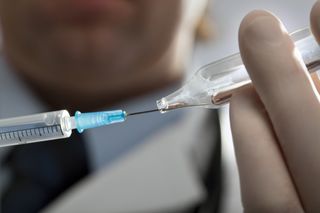Vaccine Against Common Stomach Bug Could Arrive in 4 Years

VANCOUVER, Canada — Scientists are getting closer to producing a vaccine against norovirus — the number one cause of foodborne illness in the United States.
Researchers have now tested norovirus vaccines in a limited number of human trials, said Charles Arntzen, co-director of the Center for Infectious Diseases and Vaccinology at Arizona State University. But more studies need to be done in people to garner how effective it is, Arntzen said.
If all goes well, a norovirus vaccine could come to market in the next four to five years, Arntzen said, speaking to reporters here today at the annual meeting of the American Association for the Advancement of Science.
Norovirus causes about 5.5 million cases of foodborne illness in the United States each year, or 58 percent of all foodborne illness, according to the Centers for Disease Control and Prevention. Salmonella, on the other hand, causes just 11 percent of cases, the CDC says. The virus can also spread from person to person, and through water. Symptoms include vomiting, diarrhea and stomach cramping.
Although the virus is perhaps best known for causing illnesses that spread on cruise ships, most cases, around 60 percent, occur in long-term care facilities, such as homes for the elderly, said Jan Vinjé, of the CDC.
The vaccine will likely be delivered as a nasal spray, which studies have shown induces a much stronger immune reaction against norovirus than an oral vaccine, Arntzen said. It would contain virus-like particles that resemble the two main strains of norovirus, but do not cause disease. Arntzen is collaborating with several companies to develop a vaccine, and receives funding from the company BioVaxx, Inc.
The company Ligocyte Pharmaceuticals is in the lead with testing their vaccine in people, Arntzen said. In a study published in the New England Journal of Medicine in December, researchers from Ligocyte showed a vaccine administered a few weeks before exposure to norovirus was about 60 percent effective in preventing illness (37 percent of participants who received the vaccine became ill, compared with 69 percent of participants who received a placebo). Before a vaccine can come to market, it needs to be about 80 to 90 percent effective, Arntzen said.
Sign up for the Live Science daily newsletter now
Get the world’s most fascinating discoveries delivered straight to your inbox.
Because norovirus evolves rapidly, it may need to be administered every year, like the flu vaccine, Arntzen said. At first, it would likely be targeted toward at-risk populations, including the young, the elderly, kids in daycare and travelers, Arntzen said.
Currently, the best way to prevent norovirus infection is to wash your hands with soap and water before eating or preparing food, according to the CDC. Hand sanitizers can also be used if soap and water are not available, but these may not be as affective as hand washing at preventing infection, said Natalie Prystajecky, of the University of British Columbia.
Those who fall ill should not prepare food for at least three days until after they recover from their illness, the CDC says.
Pass it on: Researchers have made progress towards a norovirus vaccine, but more human studies are needed.
Follow MyHealthNewsDaily staff writer Rachael Rettner on Twitter @RachaelRettner. Find us on Facebook.

Rachael is a Live Science contributor, and was a former channel editor and senior writer for Live Science between 2010 and 2022. She has a master's degree in journalism from New York University's Science, Health and Environmental Reporting Program. She also holds a B.S. in molecular biology and an M.S. in biology from the University of California, San Diego. Her work has appeared in Scienceline, The Washington Post and Scientific American.
Most Popular

